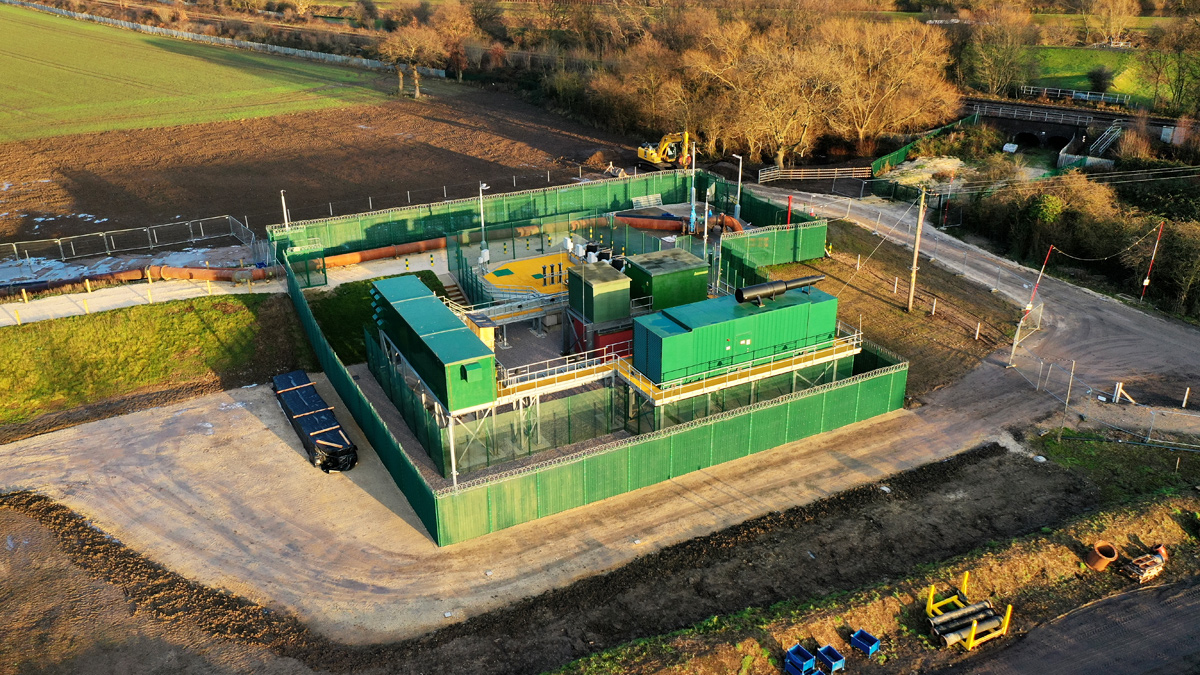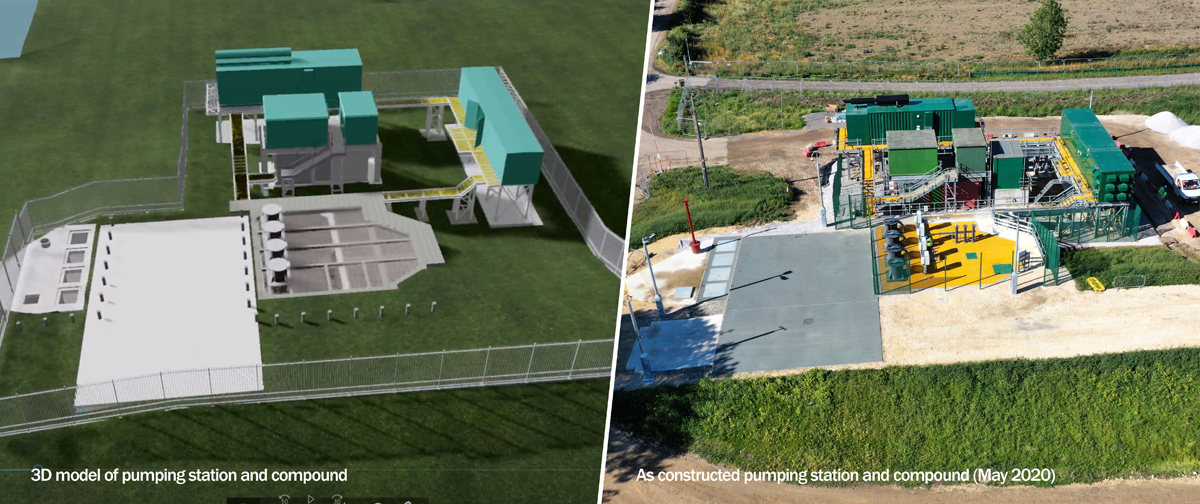Bentley Ings Pumping Station (2021)

Bentley Ings Pumping Station nearing completion in January 2021 - Courtesy of JBA Bentley
Bentley Ings Pumping Station is located within the River Don flood corridor, north-east of Doncaster and protects over 3,000 residential and 172 commercial properties from fluvial risk. The pumping station was constructed in 1942 and failed in 2007 during an extreme River Don flood event, resulting in flooding to over 1,000 properties. The aim of this project is to provide a major upgrade and refurbishment to this strategically important asset, greatly increasing its flood resilience over the extended asset life of 50 years, thereby ensuring that 1,669 properties are better protected from flooding. Storm pump, power and access resilience are the critical upgrades required to ensure project success.
Key project driver
The key driver was to replace the existing, obsolete pumps and associated mechanical and electrical components and maximise the reuse of the existing wet well and culvert structures instead of providing a new, more expensive pump station 3km downstream.
Reusing and remodelling existing structures ensured the solution was sustainable, with a robust temporary pumping station operating during the 18-month construction phase. Having overcome challenges including a major flood event, at the time of writing (March 2021) the project is nearing completion and handover back to the Environment Agency.

Bentley Ings Pumping Station model and as constructed comparison – Courtesy of JBA Bentley
A sustainable solution: Modifications to existing structures
While over 70 years old, many of the existing structures at Bentley Ings were in remarkably good condition. This, coupled with client’s drive to ensure minimal embodied carbon in the scheme, enabled the project team to reuse approximately 80% of the below ground structures during the refurbishment.
Significant structural alterations to the existing wet and dry wells were required to accommodate the modern pumping equipment, effectively increasing the station capacity by 20%. Detailed structural and dimensional modelling of each temporary stage demonstrated that safe alteration and future operation of the assets was achievable. The design team went on to further refine the solution to combine functions of the new structures. For example, temporary structural propping required to allow safe removal of supporting floors became permanent and enhanced to provide part of the buoyancy restraint system.
Raising the concrete wells and providing additional buoyancy resistance will ensure resilience in all anticipated flood conditions, and all critical electrical components are now well above the 1 in 1000-year flood level. The use of 3D modelling through the supply chain meant the limited tolerance and lack of detailed records could be managed during the design phase and on to site.

The existing wet well being modified including removal of pipework and concrete beams – Courtesy of JBA Bentley
Quality of design: Temporary pump station
Pumping capacity had to remain on-line and available at all times during the works; flood protection to the homes and businesses served by the station could not be compromised. A significant temporary over pumping scheme was designed, installed and commissioned ahead of refurbishment works commencing. To ensure efficiency and resilience, a 3-stage system was used with each stage having power and hydraulic cross-connection capacity for maximum flexibility. Flood contingency had to be considered for every activity and phase – resilience and redundancy was built-into each component and scenarios were modelled and tested to remove the need for in-the-field decision making. The wider client operational team ran emergency drills to ensure contingency plans were refined and effective in all flood conditions.

Temporary over pumping set-up by Selwood Pumps, one of the key suppliers for the project – Courtesy of JBA Bentley
Procurement decisions for the over pumping system considered the future reuse or recycling of components. For example, early consideration for reuse ensured that rising main pipework was recycled upon completing the works. In addition to learning and knowledge, the project team brought equipment and materials from the Foss Barrier scheme to be reused here.
Working collaboratively and sharing risk, the project team brought forward key areas of the programme to ensure additional resilience during construction – most notably, a permanent standby generator was installed early and used several times during the works, including during the loss of the grid supply during a gale.
Best practice: Flood access
Given the local topography and flood response of the River Don, the pumping station and current access track is located within the flood plain. While numerous layers of resilience, monitoring equipment and even partial remote operation was built-into the design, the client’s operational teams require access to the plant in all weathers and flood conditions. Several options, alternatives and combinations were reviewed. The chosen 2km route makes use of around 1.75km of existing flood embankments and berms to allow access the site in the highest foreseeable flood conditions.

Overview of the site showing the 2km emergency access track – Courtesy of JBA Bentley
The final 200m section must cross the actual river flood plain. Careful consideration and detailing were required to ensure not only affordability and minimal embedded carbon of the solution, but also no detriment to capacity or flow movement in the flood corridor. Bridging and concrete-based solutions where quickly ruled out as they did not meet the project’s carbon challenge. Instead, corrugated steel parabolic culverts were chosen as they maximise the flow area and trafficking capacity versus alternatives on the market. The lightweight nature and ability to tolerate settlement allowed further refinement of the foundation solution.
Piling of the soft alluviums in the flood plain was removed in favour of a ground improvement and a stabilised platform arrangement saving further cost and carbon. In total, a carbon reduction of 77% (or saving 5000T of concrete) in comparison with the original design was achieved.

Bentley Ings Pumping Station showing flood access to pumping station and 19 corrugated steel parabolic culverts – Courtesy of JBA Bentley
Safely overcoming challenge: Emergency response
The entire system was put to the test during the November 2019 floods, when the highest recorded levels in the River Don and flood plain struck site. The temporary pumping system, contingency planning and new resilience measures performed well, keeping people and properties protected. When several areas of the defence and system started to approach their limits, and with the site already submerged beneath 2m of water, the team stepped in to work with the EA, RAF, army and emergency services to assist with shoring up defences. As water levels rose there were major concerns of residential flooding in and around Doncaster. The team worked tirelessly alongside the RAF and army, to prevent a major flooding incident and further damage to the site.

RAF Chinook helicopter called in to help reinforce defences during the November 2019 floods – Courtesy of JBA Bentley
Stakeholders
The project is an important site for the Environment Agency, situated near the centre of Doncaster with many different stakeholders. Due to previous flooding events, it was imperative for the client that a robust temporary over pumping system was devised and implemented before permanent works commenced. A thorough contingency plan was developed and regularly reviewed during the different construction phases to ensure all stakeholders were aware if flooding was to occur again.
Bentley Ings Pumping Station: Supply chain – key participants
- Principal designer: JBA Bentley (a joint venture between JN Bentley and Jeremy Benn Associates)
- Electrical contractor: Robinsons M&E Ltd
- Corrugated culverts: Watermark
- Demolition: Ron Hull Demolition
- UV lining: Peter Duffy Ltd
- GRP lining: iLine Technologies Ltd
- Fire suppression: Bryland Fire Protection
- Steelwork: Steelwork Engineering Services
- Control equipment: Total Automation & Power
- Security fencing: Burn Fencing
- Kiosk installation: Morgan Marine
- Concrete repairs: APA Concrete Repairs
- Temporary over pumping pipework and pumps: Selwood Pumps
- Temporary over pumping pipework: Westwood Pipelines
- Back-up generator: Shenton Group
- Permanent pump supplier: Xylem Water Solutions
- 1000mm pipework Electrosteel Castings (UK) Ltd
- Dry weather pump supplier: Hidrostal Ltd
Full pumping capacity achieved
Whilst the permanent works continue towards a fully integrated site, full pumping capacity was achieved in July 2020. The maximum capacity with all 4 (No.) pumps running simultaneously is 4.4m3/s (4,400 l/s). This pumping capacity is an increase of 20% and provides enhanced flood protection to the residents and businesses of Bentley.
Conclusion
The refurbished pump station with new M&E equipment has now been operational for 6 months whilst further permanent works are completed. Through the challenges of exceptional winter flooding and more recently Covid-19 restrictions, the team have worked over 150,000 safe hours to deliver the scheme. Through the reuse and modification of existing structures, the team monitored, evaluated and reduced carbon in the project from the strategic outline case through to full business case by challenging scope, innovating our design approach and considering construction methods from the outset. The project is nearing completion and currently, when compared to the carbon baseline, capital carbon has been reduced by 60%.
A collaborative team approach between the client, designers and contractors has provided great synergy and has produced whole life cost, programme and carbon savings, and provided the local area with a valuable asset that will serve them for many years.







